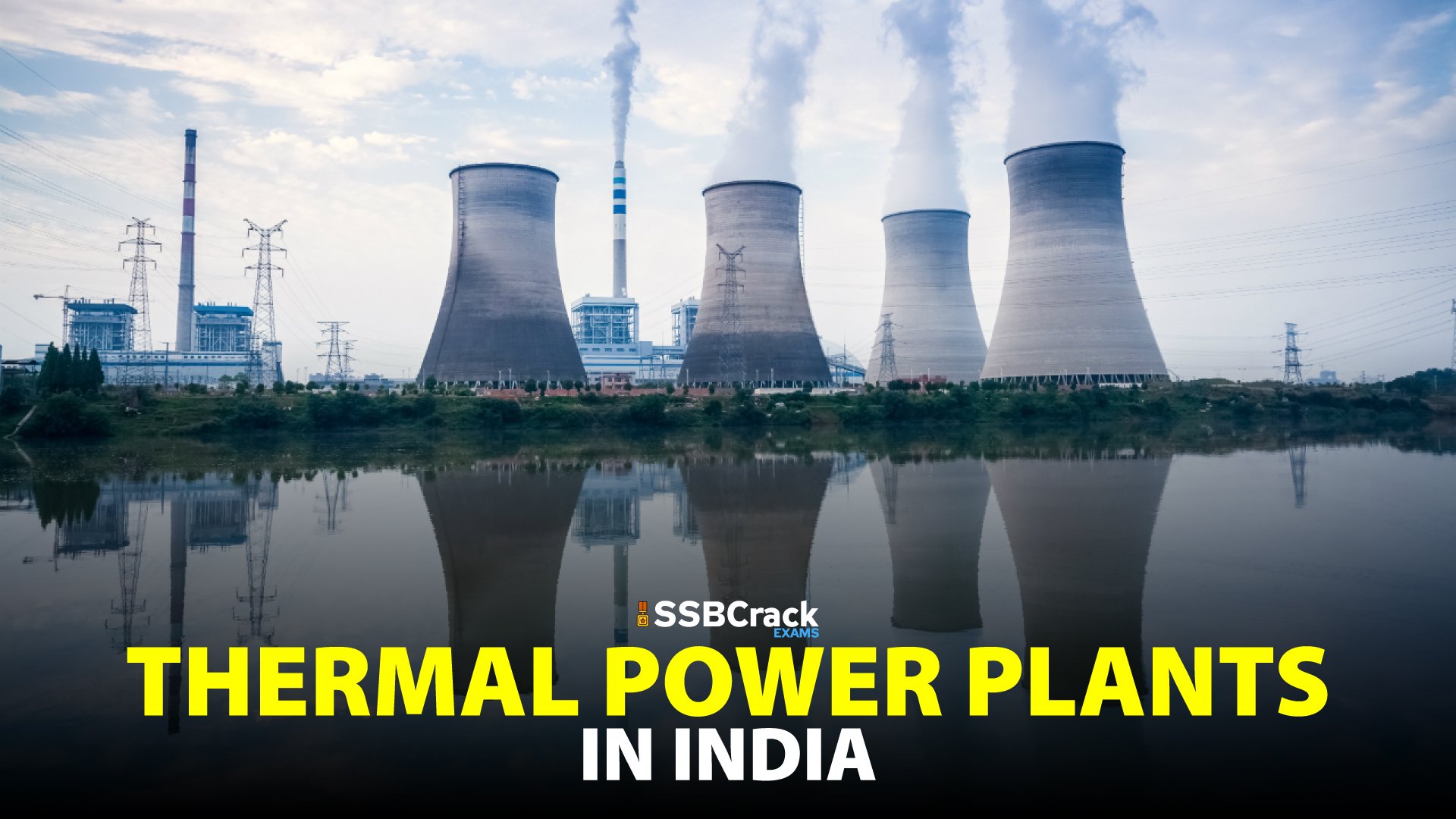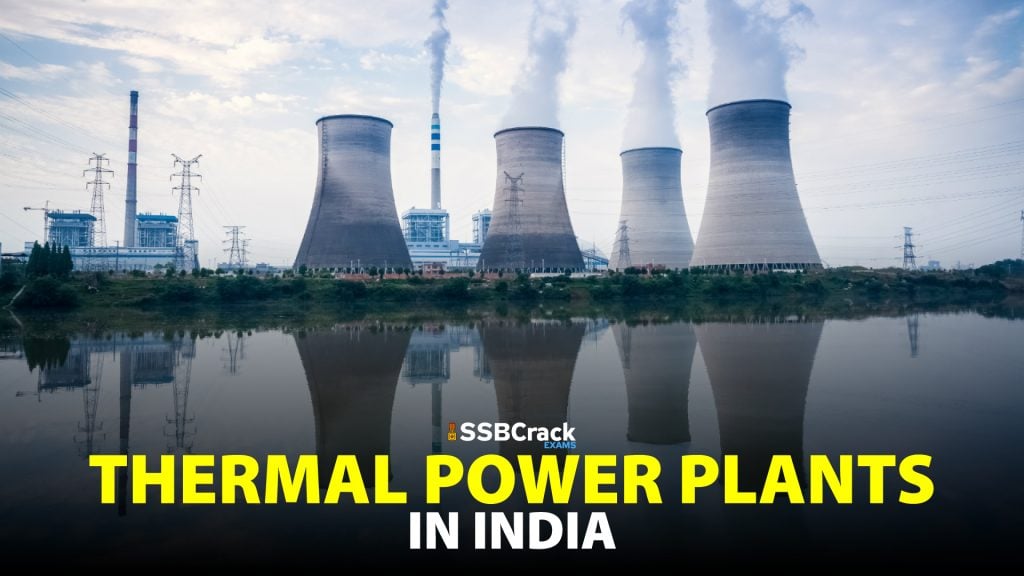Thermal power plants contribute a major amount of electricity to the process of power generation in India. The total installed power generation capacity in India as of June 30, 2021, is 3,84,115.94 MW. Thermal power plants hold great importance in India’s economic development. Hence, it is one of the most important exam topics from where a lot of general question arises.
The candidates preparing for nay government or competitive exam must be aware of the thermal power plants and their basics. For our aspirants, we have discussed every part of this topic. The candidates are advised to read the article till the end.
What is a thermal power plant?
A thermal power plant is a power plant in which steam energy is converted into electricity through the steam turbine.
The turbine blade turbine shaft attached to the generator is rotated by steam. The turbine impeller’s kinetic energy is converted into electric energy by the generator. On the other hand, purified water and air are supplied into the boiler drum, where the fuel’s combustion heat is transferred to water and converted into high-pressure, high-temperature steam. The Rankine cycle is the term for this process.
In the process of electric power generation, steam-powered turbines convert heat into mechanical power and then finally electric power.
Types of thermal power plant
- Based on heat Source
Heat plays an important role in electricity production. So the sources of heat are used to classify the type of thermal power plant. `
Below are given the sources of heat production of the thermal power plants:-
- Coal-Fired
Coal is the major source of energy in thermal power plants. Around 85% of energy sources are derived from coal. Coal is a fossil fuel, hence it emits harmful gases as well. To make energy production more sustainable, industries are now opting to alternatives.
- Diesel or Liquid fuel
Liquid fuel-based thermal power plants are also run. They are more accessible and efficient to use. One litre of heavy oil normally produces approximately 41,000 kJ (10,000 kcal) of heat and that is why it is one of the most reliable sources of energy to be used in thermal power plants.
- Geothermal
Geothermal energy is heat within the earth.it is a renewable source of energy. Hence, it is less polluting and adequate for industrial use.
- Gas
Fuel is burned in the compressed air inside combustors to generate gas, and the resulting large power is utilized to spin gas turbines. It is less polluting and provides a great alternative for coal.
- Biomass
Biomass is a plant or animal material used as fuel to produce electricity or heat. It is the most sustainable way of producing electricity because biomass is made of scrap plants and animal residue.
- Based on Installing capacity
India typically uses three types of thermal power plants. These power plants have their installing capacity, and thus it is a source of classification of the thermal power plants. Here we have provided the three types of thermal power plants based on their installing capacity:-
- Coal: 206404.50 MW
- Gas: 24956.51 MW
- Liquid Fuel(Diesel): 509.71 MW
India, as of June 30, 2021, has a total installed power generation capacity of 3,84,115.94 MW.
And around 70% of the total power generation in India is covered by thermal power plants.
Factors responsible for the location of the thermal power plants
There are many factors associated with the location of the thermal power plants. While situating the thermal power plants, these factors are taken into consideration. These factors are equally important from the exam perspective.
- Terrain
Power plants need a wide range of land equipment and technologies. As for a coal-based thermal power plant, a larger area of land would be required, whereas a natural gas fitted power plant would require a smaller area for functioning.
The terrain with easy to transport facility will attract more thermal power plants as compared to the mountain-based areas.
- Availability of Fuel and Water
Many power plants use water from lakes, rivers, municipal water utilities, or groundwater. Water plays a powerful catalyst in the process of power production. Mostly, Surface water is used for plant cooling and groundwater is used for plant processes.
Likewise, an adequate supply of fuel provides fewer chances of alternative fuel adaptability. This lessens down the financial burden of changing fuels.
So, locations with an adequate water supply and constant availability of fuel are mostly preferred.
- Proximity to population centres
The thermal power plants are located at a far distance from the population centres because of many factors such as pollution, visual and noise effect. To create a visual and sound barrier, the distant locations for thermal power plants are chosen.
- Accessibility
Power plant construction and operation can require road, rail, or barge access to the site. Sites with access to roads only are less desirable as compared to the areas with roadways, waterways accessibility. Hence, accessibility plays a major role in determining the location of the thermal power plants.
List of Thermal power plants in India
Now, we will look at the list of thermal power plants based in various states.
| State | Thermal Power Plant |
| Madhya Pradesh | Amarkantak Thermal Power Plant |
| Madhya Pradesh | Satpura Thermal Power Plant |
| Madhya Pradesh | Sanjay Gandhi, Birsinghpur Thermal Power Plant |
| Madhya Pradesh | Shri Singaji Thermal Power Station Dongalia |
| Madhya Pradesh | Vindhyachal Thermal Power Station |
| Madhya Pradesh | Singrauli Super Thermal Power Station |
| Maharashtra | Amravati Thermal Power plant |
| Maharashtra | Chandrapur Thermal Power plant |
| Maharashtra | Khaperkheda Thermal Power plant |
| Maharashtra | Tiroda Thermal Power plant |
| Maharashtra | Chandrapur Thermal Power plant |
| Maharashtra | Solapur Super Thermal Power Station |
| Maharashtra | Mauda Super Thermal Power Plant |
| Uttar Pradesh | Anpara Thermal Power plant |
| Uttar Pradesh | Dadri Thermal Power plant |
| Uttar Pradesh | Feroz Gandhi Unchahar Thermal Power plant |
| Uttar Pradesh | National Capital Thermal Power plant |
| Uttar Pradesh | Obra Thermal Power plant |
| Uttar Pradesh | Rihand Super Thermal Power plant |
| Uttar Pradesh | Rosa Thermal Power plant |
| Bihar | Barauni Thermal Power Station |
| Bihar | Patratu Thermal Power Station |
| Bihar | Khalgaon Super Thermal Power Project |
| Karnataka | Raichur Thermal Power station |
| Karnataka | Bellary Thermal Power station |
| Karnataka | Yermarus Thermal Power Station |
| Karnataka | Udupi Thermal Power plant |
| Chhattisgarh | Sipat Thermal Power Plant |
| Chhattisgarh | Lara Super Thermal Power Plant |
| Chhattisgarh | Korba Thermal Power Plant |
| Chhattisgarh | Bhilai Thermal Power Plant |
| Jharkhand | Patratu Thermal Power plant |
| Jharkhand | Bokaro Thermal Power plant |
| Rajasthan | Kalisindh Thermal Power plant |
| Rajasthan | Chhabra Thermal Power plant |
| Rajasthan | Suratgarh Super Thermal Power Plant |
| Rajasthan | Kota Thermal Power plant |
| Rajasthan | Ramgarh Gas Thermal Power Station |
| Rajasthan | Anta Thermal Power Station |
| Rajasthan | Barsingsar Thermal Power Station |
| West Bengal | Durgapur Thermal Power plant |
| West Bengal | Mejia Thermal Power Station |
| West Bengal | Farakka Thermal Power plant |
| West Bengal | Kolaghat Thermal Power Station |
| West Bengal | Sagardighi Thermal Power Station |
| West Bengal | Budge Budge Thermal Power Plant |
| West Bengal | Durgapur Steel Thermal Power Station |
| West Bengal | Bakreshwar Thermal Power Station |
| Tamil Nadu | Neyveli Thermal Power Station |
| Tamil Nadu | Mettur Thermal Power plant |
| Tamil Nadu | Ennore Thermal Power plant |
| Tamil Nadu | IND Barath Thermal Power Plant |
| Tamil Nadu | Tuticorin Thermal Power Station |
| Gujarat | Gandhinagar Thermal Power plant |
| Gujarat | Ukai Thermal Power plant |
| Gujarat | Sikka Thermal Power plant |
| Gujarat | Mudra Thermal Power plant |
| Gujarat | Wanakbori Thermal Power plant |
| Gujarat | Kutch Lignite Thermal Power Station |
| Gujarat | Akrimota Thermal Power Station |
| Gujarat | Sabarmati Thermal Power Station |
| Odisha | Hirakud Captive Thermal Power plant |
| Odisha | Talcher Thermal Power plant |
| Odisha | Jharsuguda Thermal Power plant |
| Andhra Pradesh | Simhadri Thermal Power plant |
| Telangana | Ramagundam Thermal Power plant |
| Assam | Namrup Thermal Power Plant |
Conclusion
Thermal power plants are an important energy source for the electricity supply in India. With the increasing population, the consumption of electricity is also increasing. This tends more focus towards the increase in the number of thermal power plants. It is also a significant topic from the competitive exam perspective. Thermal power plants are categorized by the heat source they use and their installing capacity.
The major source of heat energy in thermal power plants is coal, which is a non-renewable resource, depleting at a very fast rate. Other alternatives are more sustainable such as biomass, gas, geothermal energy etc. there are many small and big thermal power plants spread across various states in India. The list of the same is given above. Hope you liked this article and if you have any questions or queries, drop us a comment below.
Thank you!
Also Read:
- List Of Major Ports In India
- Natural Vegetation Of India: Geography Notes For All Defence Exams
- Project Elephant And Elephant Reserves In India
- Types Of Wind – UPSC CDS NDA Geography Notes
- Classification Of Soil In India – Types Of Soil In India
- List Of Geographical Indications [GI Tags] In India
- List Of Biosphere Reserves In India
- List Of National Parks In India
- List Of Dams In India [Highest, Longest, Largest, Oldest & State-Wise List]
- List Of Tiger Reserves In India




















